The occupants of the vinyl-coated military tents at this remote jungle camp in Brazil’s wild west compare the hellscape surrounding them to catastrophes old and new: the extinction of the dinosaurs, the bombardment of Gaza, the obliteration of Hiroshima during the second world war.
“It’s as if a nuclear bomb has gone off. There’s no forest. There’s nothing. Everything’s burned. It’s chaos,” said Lt Col Victor Paulo Rodrigues de Souza as he gave a tour of the base on the frontline of Brazil’s fight against one of its worst burning seasons in years and a relentless assault on the greatest tropical rainforest on Earth.
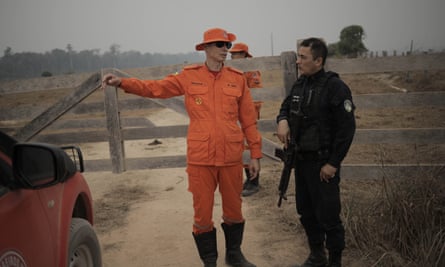
For weeks now, forests and farms here in the Amazon – and across Brazil – have been ablaze like seldom before thanks to a highly combustible cocktail of extreme drought affecting nearly 60% of the country, the climate crisis and a seemingly insatiable appetite to destroy the environment for immense financial gain.
At the front of the camp, an excavator has built a defensive firing position to protect the 100-or-so firefighters and police living here from a possible attack from the illegal loggers and land grabbers who have spent recent years cutting and torching huge areas of rainforest to create farmland and pastures. Beyond that 3ft earthwork lies an immensity of destruction: tens of thousands of acres of wood and ploughland that is going up in smoke, obscuring the sun and filling the skies with a toxic white haze.
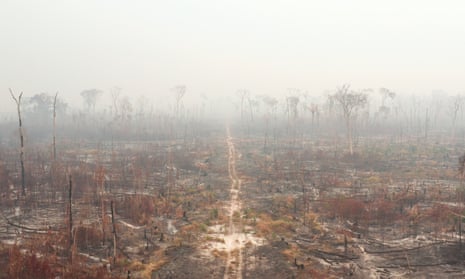
“It’s been burning here for over 40 days,” said Souza as his firefighters prepared for their latest mission to put out fires that are also wreaking havoc in neighbouring Bolivia and Peru. “You couldn’t breathe at the base yesterday. Everyone was wearing masks … At 9am it was like it was night because you couldn’t see sunlight.”
The Guardian spent three days at the Rubber Soldier Ecological Station encampment near a logging outpost called Cujubim to witness government efforts to control the flames before they cause even more harm.
Cujubim is named after an Amazonian bird – the red-throated piping guan – which is native to this part of Rondônia, one of nine Amazon states. The town’s streets pay tribute to the abundance of birdlife that inhabits the region’s jungles: Musician Wren Avenue, Dark-winged Trumpeter Road, Woodpecker Way.
The avian theme obscures a menacing reality caused by the criminal race to cash in on the region’s supposedly protected forests. A sign welcoming visitors to Cujubim is riddled with bullet holes. On one recent morning two men were shot in the head at the intersection of Curassow Avenue and Jabiru Stork Road.
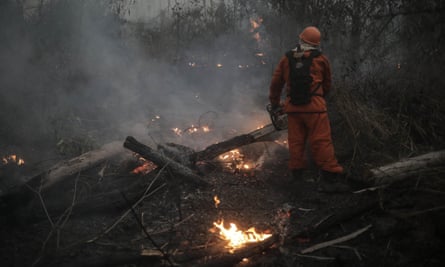
There is scant sign of birdlife on the dirt track that meanders north from Cujubim towards the firefighting base bar the occasional pair of macaws whose scarlet feathers contrast with the pale white smog. That road takes its name not from nature but from a notorious forest wrecker called Chaules Pozzebon, who locals say built it in order to access the pristine jungles that lie beyond.
Once dubbed “the Amazon’s biggest deforester”, Pozzebon was arrested in 2019 and jailed for 99 years for running an armed criminal organization, although he was recently released after his sentence was slashed. “He sowed terror around here … He was the boss of the forest,” one police officer said of Pozzebon, who owned more than 100 sawmills and allegedly employed a militia of gunmen to guard the wilderness he controlled.
A bone-jolting 90-minute drive up the Estrada do Chaules (Chaules’s Road), the firefighting base comes into view: a dusty campground beside the Curica River, which is connected to the outside world by a Starlink satellite dish.
That internet connection allows firefighters to detect fires as they break out around them. Last week satellite imagery showed that, despite their efforts, the situation was getting worse. “In our first week here we reduced the number of outbreaks to 17 a day. But since yesterday it’s risen from 17 to 59 – and today it’s over 80,” said Souza, blaming “reprisals” from environmental criminals enraged by the government’s struggle to extinguish the fires.
Three large trees had been felled across jungle roads to prevent fire crews arriving. Elsewhere steel bars had been turned into improvised spike strips designed to puncture their tires. “It’s like guerrilla warfare. They’re trying to stop the firefighters getting in to put out the forest fires because they want to clear the area,” said the fire chief, who wore a pistol on his hip.
Hours later, at a blaze just south of the camp, Souza spotted the melted remains of a plastic gasoline container near the carcass of a decades-old Brazil nut tree that had burned to the ground. Motorbike tracks were visible nearby but the fire-starter was long gone. “It’s like a favela in the jungle, full of back alleys and lanes,” Souza said, likening the vast rainforest region to one of Rio’s maze-like shantytowns. “The invaders know every single trail so it’s nearly impossible to catch them.”
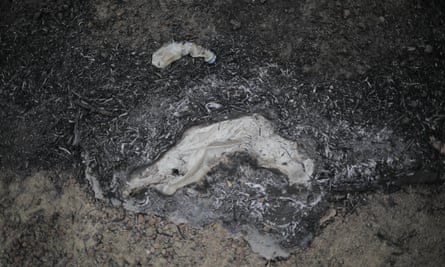
The wildfires – more than 120,000 of which have broken out since August, mostly in the Amazon – are easier to locate, although not always in time.
The next morning a convoy of firefighters and police left the Rubber Soldier base and drove for two hours through a post-apocalyptic landscape of fallen trees and scorched earth. After passing the putrefying corpse of a horse which appeared to have been bitten by a snake, the group discovered an illegal sawmill at the heart of a colossal expanse of freshly razed forest. Sawed timber and empty beer cans littered the patio. The fire had burned itself out but the damage was done.
“I can’t tell you how it started. All I know is that it came from over there,” said Damião de Andrade, 53, a migrant worker from Bodocó in Brazil’s impoverished north-east, who police detained for questioning at a neighbouring ranch.
Experts say a lack of rain associated with the natural climate phenomenon El Niño and searing temperatures during what is expected to be the world’s hottest year on record have turbo-charged the wildfires. But the overwhelming majority of the blazes were deliberately set.
Carlos Nobre, one of Brazil’s leading climatologists, suspected the explosion of burning – not just here in the Amazon but in the Pantanal wetlands, the Cerrado tropical savanna and as far south as São Paulo – could be part of a criminal counterattack designed to sabotage a federal government crackdown on deforestation and illegal mining.
Since the leftist Luiz Inácio Lula da Silva became president in January 2023 Amazon deforestation has fallen sharply, after four years during which it soared under his far-right predecessor, Jair Bolsonaro. Nobre said environmental criminals considered Lula’s administration – and other South American leaders who were also fighting deforestation – “a wartime enemy”, unlike Bolsonaro whose anti-environmental policies meant they saw him as a friend. A drought that authorities call “the most intense and widespread” in Brazilian history and the associated heatwaves had given such criminals a golden opportunity to sow chaos. “It’s war – they want to bring these governments down,” Nobre said.
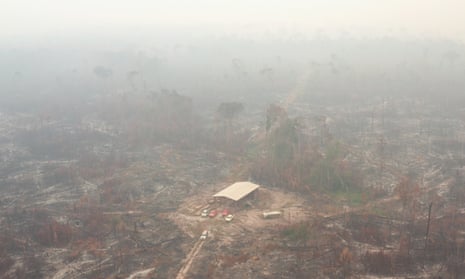
This week Lula’s environment minister, Marina Silva, accused the fire-starters of committing “climate terrorism” and called for tougher punishment for such crimes.
As federal police investigators work to identify those responsible for this year’s inferno, hundreds of intrepid, soot-smeared firefighters continue to battle the flames with machetes, leaf blowers and chainsaws.
“It’s like walking into a cemetery … Everything here was alive once. Now it’s all dead,” said José Baldoíno, a 41-year-old firefighter as he led his nine-strong team into its latest conflagration where bright orange flames were ripping through the carbonized bush.
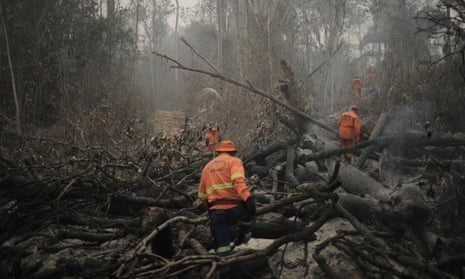
As night fell, Baldoíno, who works for a federal forest fire unit called Prevfogo, ordered his squad to retreat for fear of being crushed by falling trees. They had been working since 6am. But the next morning the men woke before dawn, donned flame-resistant uniforms and raced back to the front.
In the Bible, “it says the world will end in fire – and what we’re witnessing today isn’t far off the scriptures,” Baldoíno reflected, remembering the record-breaking wildfires that have also hit countries as far apart as Canada and Portugal.
After a month in the jungle, Baldoíno admitted his men’s bodies were weary but vowed they would not give up the fight. “Our souls are crying out for a happy ending.”
Source: theguardian.com


